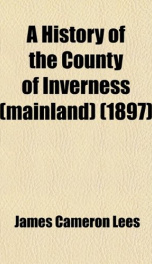a history of the county of inverness mainland

Purchase of this book includes free trial access to www.million-books.com where you can read more than a million books for free. This is an OCR edition with typos. Excerpt from book: CHAPTER III. INVERNESS-SHIRE DURING THE SCOTTISH WAR OF INDEPENDENCEEDWARD I. OF ENGLAND IN THE NORTHTHE CASTLE OF URQUHART A STRONGHOLD OF THE PATRIOTIC PARTYRANDOLPH, EARL OF MORAYHIS VIGOROUS RULEDAVID II. AT INVERNESSGREAT SOCIAL CHANGES IN THE COUNTYESTABLISHMENT OF THE CLAN SYSTEMTHE FRASERS, GRANTS, CHISHOLMS, CAMERONS, AND OTHERS BECOME HEADS OF CLANSTHE CLAN SYSTEM IN THE MAIN A DEVELOPMENT OF THE NORMAN POLITY THE FIRST NOTICE IN HISTORY OF THE CLANS CONNECTED WITH INVERNESS-SHIRE FEUD BETWEEN THE CLAN CHATTAN AND THE CLAN CAMERONBATTLE OF INVERNAHAVON CONFLICT ON THE INCH OF PERTH. The county of Inverness was not affected to the same extent as other parts of Scotland by the long struggle which issued in the independence of the kingdom. It was far away from the great scenes of conflict, and the contending armies which traversed other counties left its soil almost untrodden. The great territorial lords among whom the shire was partitioned had indeed to take part in the national conflict, and, as far as we can learn from the annals of the time, they were on the patriotic side. A. John of Glen- urquhart and a son of John of the Aird were among the prisoners taken by the English after the battle of Dunbar (1296). Andrew Moray, son of Sir Andrew Moray of Petty near Inverness, and of Avoch in Ross, was a close companion of Sir William Wallace, and represented his interest among the Highlanders. David, Bishop of Moray, was a chief supporter of King Robert Bruce, and preached throughout his diocese a crusade in his favour. Names well known in after-years in the history of Inverness-shire appear in the historic narrative. A Simon Fraser, a John Cambron, and a Mackintosh are named among the followers of the Scottish monarch. At Bannockburn, it is said, as man...
Info about the book
Author:
Series:
Unknown
ISBN:
1143716418
Rating:
3.5/5 (5)Your rating:
0/5
Languge:
English
Users who have this book
Users who want this book
What readers are saying
What do you think? Write your own comment on this book!
write a commentif you like a history of the county of inverness mainland try:
Other books by this author
Do you want to read a book that interests you? It’s EASY!
Create an account and send a request for reading to other users on the Webpage of the book!


